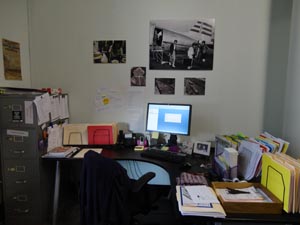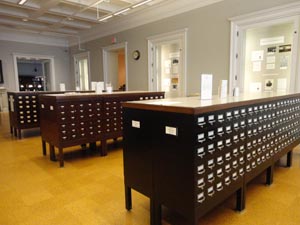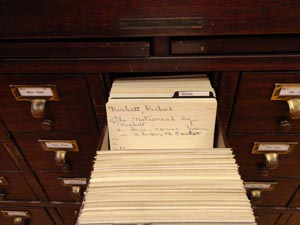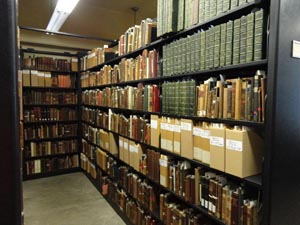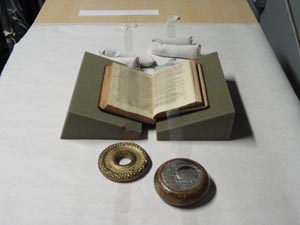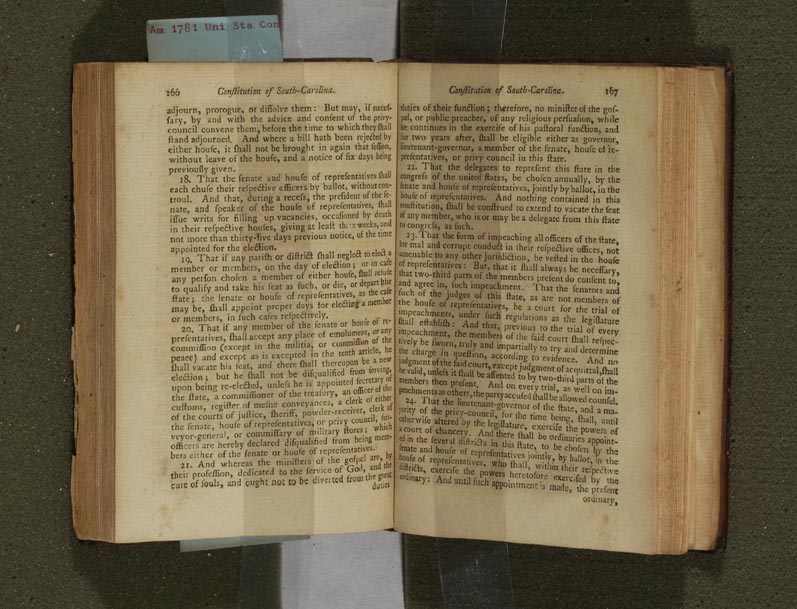Since becoming HSP’s Rights and Reproductions Associate in July 2011, I’ve fielded countless questions about what exactly “R&R” entails. I often tell curious folk that I handle orders for digital copies of HSP materials and the rights to publish these materials in books, exhibitions, and other media, but this description only skims the surface of how a reproduction request goes from first contact to completed order. Inspired by my colleague Cary Majewicz’s fabulous blog entry on a day in the life of an archivist, what follows is an insider’s look at a day in MY life as HSP's Rights and Reproductions Associate.
Date: Not so long ago
Time: The standard work day, 8:30-5:00 with ½ hour lunch
Place: The Historical Society of Pennsylvania, 1300 Locust Street
|
Around 8:30, I arrive at the Digital Center on the 4th floor and log into my computer. While the activities I undertake for R&R (research, record creation, digitization, etc.) can vary greatly from day to day, one constant is that I always begin my day by checking the R&R e-mail account. In an average week, I receive about 10 to 15 R&R requests, which adds up to about 50 requests per month. The nature of these requests run the gamut, from authors who have already identified an image in our digital library, to genealogists looking for family history materials in our online catalog, to those individuals who need me to research and identify items for them. Not every request turns into a full-fledged R&R order - I refer some requests to our Research by Mail service, which tackles more extensive research questions and can provide patrons with summaries and photocopies of their findings.
Wading through the inbox, I make mental notes about responses and next steps, particularly those that require research of collection materials. This particular morning, I have two new requests that fit that bill. The first is from a representative at a new Harriet Tubman museum and visitor center who needs specific entries from William Still’s journal of the Underground Railroad. The second request is from a researcher interested in watercolors and manuscripts by Richard Nisbett, an artist and poet who was also a patient at a Pennsylvania mental hospital in the early 1800s. I jot down some quick notes about these requests and spend about 30-40 minutes responding to e-mails, sending out invoices, and other correspondence before delving into my research.
|
I decide to start with the request for entries from William Still’s journal of the Underground Railroad, which is already digitized and available for view in our digital library. The patron is requesting images of 14 entries, several of which mention Harriet Tubman. The entire volume consists of about 200 images and it takes me about an hour to browse each image and locate the entries the patron has requested. I e-mail my findings to the patron, along with information on the reproductions process and questions about her project. All told, the average R&R order involves at least 1 to 2 hours of research and correspondence before digitization even occurs, including time spent locating materials, determining reproduction and usage fees, invoicing patrons, and processing payments.
After all the e-mail and image browsing, I need a break from my computer so now seems like a good time to search for materials by Richard Nisbett. I begin with our online catalog and find a volume of poems by Nisbett, which is actually stored next door at the Library Company of Philadelphia. Since our buildings are adjacent, HSP keeps some materials on deposit at the Library Company and vice versa and I occasionally go to the Library Company to pull one of our items. I look up the volume’s call number in the Library Company’s online catalog, then make my way downstairs to HSP’s card catalogs.
|
Since the patron is interested in the full extent of our materials by Richard Nisbett, I search both the graphics and manuscript catalogs. Unfortunately, I don’t find any watercolors or other graphics by Nisbett, but I do find an entry for another volume of poems in the Simon Gratz autograph collection.
|
Conveniently, the Gratz collection is stored on the first floor and I locate the volume on the shelf without too much trouble. While I’m still on the first floor, I grab the key to the Library Company, which is accessible through the “Limbo Room” on the 2nd floor. At the Library Company, I locate the other volume by Richard Nisbett and take both items back to my desk, where I can finally e-mail the patron and let him know what I’ve found.
|
Typically, I continue to research collection materials and respond to e-mails as they come in throughout the day. For statistics, I track the number of initial requests that begin R&R orders, but this is just a small portion of the e-mails I receive on a daily basis. A key part of the R&R rhythm comes from juggling several orders at once and these orders are often at different stages of completion, which leads to a fairly constant stream of e-mails between patrons and myself.
Thankfully, though, R&R involves much more than responding to e-mail and after invoicing and payment is worked out, it's time to digitize materials and post them to our digital library. Like R&R inquiries themselves, the materials that patrons order reflect the sheer breadth of our collections, from lithographs, watercolors, and photographs, to diaries and correspondence, to entire manuscript volumes. Depending on the nature of the material, digitization can take anywhere from half an hour to several days or weeks; today, I'm chipping away at a mass digitization request for an entire 280-page volume from our collection of early American monographs. Entitled The constitutions of the several independent states of America [call# Am 1781 Uni Sta Con], the volume was published in 1781 and was ordered by a man in Oklahoma who hopes to authenticate his copy using a digital copy of ours.
|
Since this is a bound volume, it can't be flattened on a scanner; instead, I've been using our overhead Hasselblad camera to photograph and edit the volume page-by-page. The book's binding is tight, which makes it particularly difficult to keep it flat and get a clean shot of the text that falls in the center of the book, what we refer to as the "gutter." My best efforts involve an oh-so-glamorous combination of a book cradle, Mylar strips, and weights to hold the pages and binding in place for each shot.
Especially towards the middle of the book, the process of setting up each page to capture as much of the text as possible is slow-going and requires 5 or 6 test shots before I'm confident enough to take the final, multi shot. The multi shot takes several minutes and consists of four shots, which are then layered and combined into one comprehensive image. Once the final image loads in the camera software, I export it to the desktop and then begin the process all over again, carefully turning the page and weighing it down. This afternoon, I capture 30 images (equivalent to 60 pages) in about two and a half hours; all told, the entire volume will take about 11 hours to digitize, followed by an additional 2 hours to format the images before sending the final product to the patron either through file transfer or snail mail.
|
Following digitization, all materials digitized for R&R are uploaded to our digital library, which now boasts over 30,000 digital images. As the Rights and Reproductions Associate, I'm also responsible for creating catalog records for digital images, as well as performing quality control checks on the records that my colleagues create. Depending on the amount of metadata involved, the average digital library record takes about 40 minutes to create and edit, a process that often includes the creation of collection and entity records for related authors, artists, and objects.
As the day winds down, I read and respond to more e-mail messages, record some payment deposits, and sign and file a few invoices, usage agreements, and other R&R paperwork. Before signing off for the day, I make a list of tasks I'd like to tackle tomorrow, including creating catalog records for new R&R orders and following up on voicemail messages. However, like every day of R&R, this list is fluid and open to change depending on what new requests and challenges greet me in the morning. Whatever tomorrow brings, I know I can expect another busy and somewhat unpredictable day in the life of R&R at the Historical Society of Pennsylvania.


